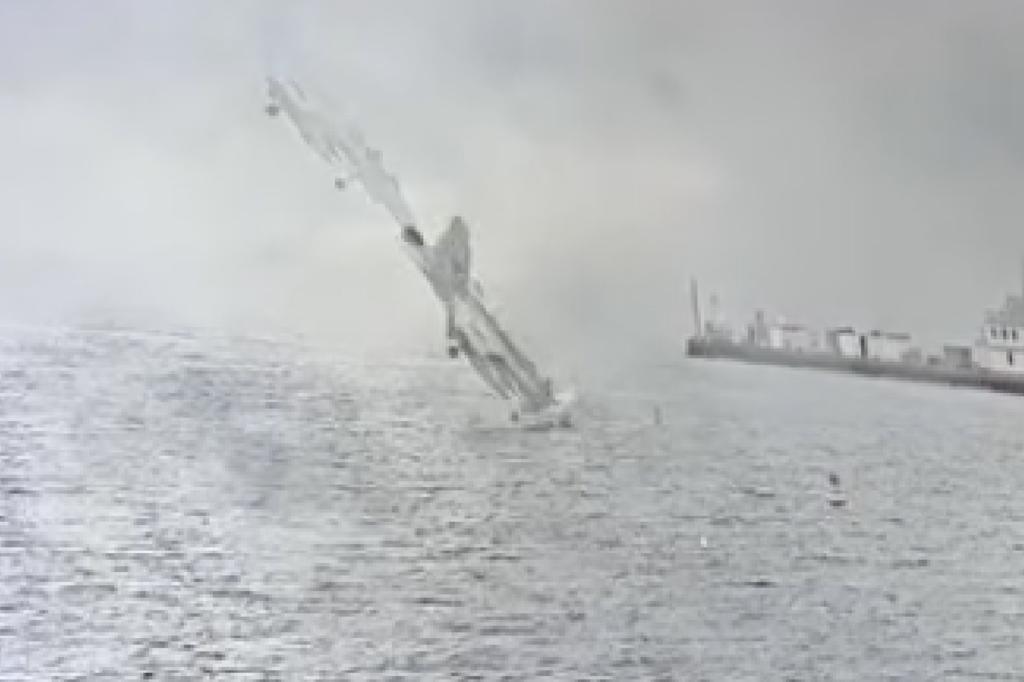World
New footage shows moment military fighter jet crashes into San Diego Bay as pilots eject safely

Shocking Video Captures US Military Fighter Jet Crash in San Diego Harbor
On Wednesday morning, a stunning and dramatic incident unfolded in San Diego Harbor as a US military fighter jet, an EA-18G Growler, crashed into the water and exploded moments after its two pilots safely ejected. The harrowing incident occurred at approximately 10:17 a.m., and video footage obtained by CBS 8 San Diego captured the entirety of the crash. The jet, which darted down from the sky, slammed into the harbor’s waters near Shelter Island, a neighborhood located across the bay from Naval Air Station North Island. The impact sent a massive plume of smoke and water into the air before the wreckage disappeared beneath the surface.
A witness described the scene to CBS 8, recounting, “The plane hit the water, and there was an explosion. A lot of black plumes, and then it just like got sucked into the water. Within 15 seconds, there was nothing.” The quick disappearance of the jet left onlookers in shock, but the most reassuring news was that both pilots had ejected safely and were rescued shortly after.
Two Navy Pilots Ejected Safely and Rescued by Fishing Boat
The two-seat EA-18G Growler jet, a $67 million advanced electronic warfare aircraft, was carrying two Navy pilots when it crashed. Both aviators managed to eject from the jet moments before impact, parachuting to safety. Their ordeal didn’t end there, as they were left stranded in the harbor’s waters, but luck was on their side.
A fishing boat, captained by Brandon Viets, happened to be in the area and quickly sprang into action. Captain Viets recalled seeing “two parachutes with two dots underneath” descending toward the water. Without hesitation, he and his crew of four turned the boat around and raced to the scene. “Luckily, we were there to spin the boat around, and thanks to my crew and everyone else, we were able to swing by and pick them up and safely get them out of the water,” Viets told CBS 8.
Photos taken immediately after the rescue show the two pilots, dressed in their soaked jumpsuits, sitting on the fishing boat. Despite the harrowing experience, both pilots were conscious and coherent when they were pulled to safety. Crew member Colin Casper, who was part of the rescue effort, shared that the pilots “seemed a little shaken up” but were more focused on checking on each other’s well-being.
Pilots Recovering as Investigation Begins
The rescued pilots were transported to UC San Diego Medical Center in Hillcrest, where they were reported to be in stable condition. Their survival is a testament to their training and the quick actions of the fishing boat crew, who played a pivotal role in ensuring their safety.
Meanwhile, the crash has sparked an investigation led by Naval Base Coronado. Harbor officials have cordoned off the waters around the crash site to contain any potential oil or fuel spills from the wreckage. The cause of the crash remains unknown at this time, and officials are working to determine whether mechanical failure, human error, or other factors were involved.
The incident is the latest in a series involving the EA-18G Growler. In October, another Growler crashed near Mount Rainier in Washington, tragically killing both pilots on board. These recent incidents have raised questions about the safety and reliability of the aircraft, which has been in service for 15 years and is considered a critical asset for the Navy’s electronic warfare operations.
The EA-18G Growler: A Critical but Troubled Asset
The EA-18G Growler, operated by two pilots, is a highly advanced aircraft designed for airborne electronic attack missions. It serves as the Navy’s first line of defense in hostile environments, capable of disrupting enemy communications and radar systems. The aircraft has been deployed in various operations worldwide, showcasing its importance to national security.
Despite its advanced technology, the Growler has faced scrutiny following recent crashes. The incident in San Diego Harbor, combined with the fatal crash in Washington, has prompted concerns about the aircraft’s safety record. The Navy has yet to release a detailed statement on the cause of these crashes, but the investigation into the San Diego incident will likely shed light on whether these events are isolated or part of a larger pattern.
Local Response and Environmental Concerns
The crash in San Diego Harbor has not only raised concerns about aviation safety but also sparked worries about environmental impact. The wreckage of the jet, along with potential fuel and oil spills, poses a risk to marine life and the harbor’s ecosystem. Authorities have moved quickly to contain the spill, but the full extent of the environmental damage is still being assessed.
Local residents and witnesses expressed shock at the incident, which took place in a bustling area frequented by tourists and sailors. “I looked over and saw the jet flying without pilots, without the cockpit on it,” said Colin Casper, one of the crew members who helped in the rescue. His account paints a vivid picture of the chaos and confusion in the moments following the crash.
A Miracle of Survival and a Call for Answers
The survival of the two pilots is nothing short of miraculous, and the role of the fishing boat crew cannot be overstated. Their bravery and quick thinking undoubtedly saved lives, earning them widespread praise from the community and officials alike.
However, the crash also highlights the risks faced by military personnel and the challenges of maintaining advanced aircraft. As the investigation into the San Diego crash continues, the Navy will be under pressure to address concerns about the Growler’s safety and ensure that such incidents are prevented in the future.
For now, the focus remains on the recovery of the pilots and the containment of the crash site. The incident serves as a stark reminder of the dangers faced by those who serve in the military and the importance of maintaining rigorous safety standards in aviation operations.
-

 Money3 days ago
Money3 days agoConsumer Financial Protection Bureau Adds Error Message To Home Page
-

 Money2 days ago
Money2 days agoWinning Content Strategies For Wealth Managers
-

 Australia1 day ago
Australia1 day agoTropical Cyclone Zelia intensifies to category 2 storm
-

 Asia1 day ago
Asia1 day agoWhat you need to know about 2024 YR4, the asteroid that could hit Earth in about eight years’ time
-

 Entertainment23 hours ago
Entertainment23 hours agoPrince Harry and Meghan Markle’s Best Moments and Photos From the 2025 Invictus Games
-

 Australia18 hours ago
Australia18 hours agoTropical Cyclone Zelia intensifies to category five system off Pilbara coast
-

 Politics1 day ago
Politics1 day agoDozens of religious groups sue to stop Trump admin from arresting migrants in places of worship
-

 Australia8 hours ago
Australia8 hours agoCyclone Zelia WA category 5 storm to hit Pilbara region near Karratha and Port Hedland











